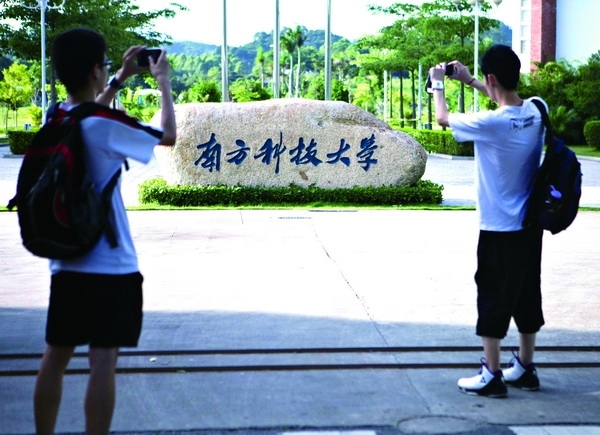


By Wu Weiting (吳娓婷)
Issue 587, Sept 17, 2012
Nation, page 10
Translated by Wang Fan
Original article: [Chinese]
17-year-old Cui Lian has been skipping grades ever since primary school. She has even patented 14 inventions.
As other students her age are busy preparing for the dreaded Gaokao college entrance exam, Cui is now a sophomore at Shenzhen’s South University of Science and Technology of China (SUSTC) – an experimental university funded by the Shenzhen local government that hopes to shed the educational status quo in China and create conditions for innovation to thrive.
“It’s important that we don’t surrender to the exam-oriented Chinese education which prevails over the mainland,” Cui said. “As innovative students, we should preserve our curiosity.”
SUSTC has some young talent. Among current freshmen, there are a number of 16-year-olds, and even a few 14-year-olds. Allowing such young students and breaking away from the Gaokao are just a few of the experimental measures the school has taken.
“One benefit of studying at SUSTC is that you’re not bound by so many rules and regulations,” said sophomore Ni Ni.
Ni has voluntarily joined a research project on solar energy led by a teacher with an extensive network of resources, thanks to which he has numerous opportunities to mingle with other prominent scholars in the field.
“We are not imbued forcefully with tons of information,” he said. “On the contrary, by interacting with academic scholars we have learned that broadening our horizons is much more important. A myriad of opportunities keep us zealous about learning.”
Attracting top professors with access to sought after people and resources is another aspect of SUSTC’s goal of becoming a cradle of innovation. Some professors are offered salaries as high as $180,000 and given relatively free-reign over their teaching methods and research focus. Last year SUSTC recruited three young associate professors, including Lu Wei, a researching assistant professor from the University of Hong Kong.
“I came here because demand for research is rising in mainland China while declining in Hong Kong,” Lu said. “The mainland will be the future stage for research. Thus, it’s better to come here earlier.”
In the eyes of most SUSTC freshmen though, their lives are just as miserable as those of their counterparts at other Chinese science and engineering universities; perhaps even more so.
English publications are used as teaching materials. Having collected physics and math textbooks over 500 pages long, students often mock themselves and their hardships saying they’re treated as “dumb knaves” or when tested they’re “like rabbits about to be hunted.” At the same time though, they’re admired by their old high school classmates.
“Students at SUSTC have a predilection for challenges,” said He Jiankui, vice professor of SUSTC’s School of Biology. “They can be preoccupied with experiments for over ten consecutive hours.”
Only one week after starting university, a freshman named Ryan was selected to participate in the 12th “Challenge Cup National Competition of Undergraduate Academic Works on Science and Technology,” which requires contestants to develop intelligent financial software. In spite of the risk he faced of squandering time and money on the competition, Ryan jumped at the chance.
Wang Huaiqing, a former professor at the City University of Hong Kong (CityU), was Ryan’s supervisor. “You just need to do the best you can in light of previous achievements,” he told his students. “Anything distinctive you can come up with, no matter how negligible it may seem, will end up being an inspiring personal success.”
Ryan has kept an eye on the development and reforms of SUSTC since his first year of high school. After basically confirming his admission to the university, he came to the school to sit in on a lecture.
Students feel the heavy attention paid to the school by Shenzhen’s municipal government. The first lecture for the 2012 freshmen entitled Shenzhen: A Pioneering City in China’s Reform Era was given by Tang Jie, vice mayor of the city. All students were required to attend.
“It is important for Shenzhen to integrate cultural education while it’s marching forward as an emerging prosperous city,” said Cui Lian, the 17 –year-old sophomore. “Its external appearance is shaped by economic development, but how far it continues to go depends on the city’s cultural legacy.”
SUSTC has faced struggles with the Organizational Department of Shenzhen’s Municipal Party Committee and the Ministry of Education over faculty and admission policies. Through these struggles, SUSTC has had to diverge somewhat from its original goal of having truly independent recruitment. At the beginning of 2011, SUSTC was also hit by the resignation of several core faculty members, including Wu Jiawei, founder of Hong Kong University of Science and Technology (HKUST). In spite of the many benefits for professors, some have said the university isn’t living up to its goals and meeting the students’ needs.
Despite these setbacks though, Ryan still identifies with SUSTC’s educational philosophy. “It’s hard for non-traditional talents like me to get into first-tier Chinese universities if we’re assessed by the Gaokao alone,” he said.
For him, whether the bachelor’s degree is issued by the university or the Ministry of Education doesn’t really matter. What counts is the kind of education he receives and whether he can learn something valuable out of it.
There were two questions he wanted to ask at the lecture given by the vice mayor. One was whether economic and cultural development can be synchronized. The other was why citizens in Shenzhen feel a decline in their happiness.
“Progress should be made in Chinese education,” Ryan said. “SUSTC is exploring just one of the possibilities, which also include things like cooperation between Chinese and foreign universities. I don’t know exactly what this progress will lead to, but what I do know is this: I care about the journey much more than the destination.”